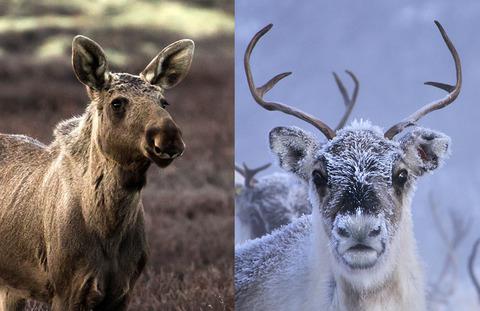当前位置:
X-MOL 学术
›
J. Anim. Ecol.
›
论文详情
Our official English website, www.x-mol.net, welcomes your
feedback! (Note: you will need to create a separate account there.)
When does weather synchronise life history traits? Spatiotemporal patterns in juvenile body mass of two ungulates
Journal of Animal Ecology ( IF 3.5 ) Pub Date : 2020-02-28 , DOI: 10.1111/1365-2656.13192 Ivar Herfindal 1 , Torkild Tveraa 2 , Audun Stien 2 , Erling J Solberg 3 , Vidar Grøtan 1
Journal of Animal Ecology ( IF 3.5 ) Pub Date : 2020-02-28 , DOI: 10.1111/1365-2656.13192 Ivar Herfindal 1 , Torkild Tveraa 2 , Audun Stien 2 , Erling J Solberg 3 , Vidar Grøtan 1
Affiliation

|
1. Theory predicts that animal populations will be synchronised over large distances by weather and climatic conditions with high spatial synchrony. However, local variation in population responses to weather, and low synchrony in key weather variables or in other ecological processes may reduce the population synchrony. 2. We investigated to what extent temperature and precipitation during different periods of the year synchronised juvenile body mass of moose and reindeer in Norway. We expected high synchronising effect of weather variables with a high and consistent explanatory power on body mass dynamics across populations, and a weaker synchronising effect of weather variables whose effect on body mass varied among populations. 3. Juvenile body mass in both species was related to temperature and precipitation during several periods of the year. Temperature had the strongest explanatory power in both species, with a similar effect across all populations. 4. There was higher spatial synchrony in temperature compared to precipitation, and accordingly temperature had the strongest synchronising effect on juvenile body mass. Moreover, periods with strong explanatory power had stronger synchronising effect on juvenile body mass in both species. However, weather variables with large variation in the effects on body mass among populations had weak synchronising effect. 5. The results confirm that weather has a large impact on the spatial structure of population properties, but also that spatial heterogeneity for instance in environmental change or population density may affect how and to what extent populations are synchronised.
中文翻译:

天气何时同步生活史特征?两种有蹄类动物幼年体重的时空模式
1. 理论预测,由于天气和气候条件具有高度空间同步性,动物种群将在远距离同步。然而,种群对天气反应的局部变化以及关键天气变量或其他生态过程的低同步性可能会降低种群同步性。2. 我们调查了挪威一年中不同时期的温度和降水在多大程度上同步了驼鹿和驯鹿的幼年体重。我们预计天气变量的高度同步效应对不同人群的体重动态具有高且一致的解释力,而天气变量对体重的影响因人群而异,同步效应较弱。3. 两个物种的幼年体重与一年中几个时期的温度和降水有关。温度在这两个物种中具有最强的解释力,对所有种群都有相似的影响。4. 与降水相比,温度的空间同步性更强,因此温度对幼体体重的同步效应最强。此外,解释力强的时期对两个物种的幼体体重有更强的同步作用。然而,对人群体重影响变化较大的天气变量同步效应较弱。5. 结果证实,天气对人口特性的空间结构有很大影响,但也表明空间异质性,例如环境变化或人口密度,可能会影响人口同步的方式和程度。在所有人群中都有类似的效果。4. 与降水相比,温度的空间同步性更强,因此温度对幼体体重的同步效应最强。此外,解释力强的时期对两个物种的幼体体重有更强的同步作用。然而,对人群体重影响变化较大的天气变量同步效应较弱。5. 结果证实,天气对人口特性的空间结构有很大影响,但也表明空间异质性,例如环境变化或人口密度,可能会影响人口同步的方式和程度。在所有人群中都有类似的效果。4. 与降水相比,温度的空间同步性更强,因此温度对幼体体重的同步效应最强。此外,解释力强的时期对两个物种的幼体体重有更强的同步作用。然而,对人群体重影响变化较大的天气变量同步效应较弱。5. 结果证实,天气对人口特性的空间结构有很大影响,但也表明空间异质性,例如环境变化或人口密度,可能会影响人口同步的方式和程度。因此,温度对幼鱼体重的同步作用最强。此外,解释力强的时期对两个物种的幼体体重有更强的同步作用。然而,对人群体重影响变化较大的天气变量同步效应较弱。5. 结果证实,天气对人口特性的空间结构有很大影响,但也表明空间异质性,例如环境变化或人口密度,可能会影响人口同步的方式和程度。因此,温度对幼鱼体重的同步作用最强。此外,解释力强的时期对两个物种的幼体体重有更强的同步作用。然而,对人群体重影响变化较大的天气变量同步效应较弱。5. 结果证实,天气对人口特性的空间结构有很大影响,但也表明空间异质性,例如环境变化或人口密度,可能会影响人口同步的方式和程度。对人群体重影响变化较大的天气变量同步效应较弱。5. 结果证实,天气对人口特性的空间结构有很大影响,但也表明空间异质性,例如环境变化或人口密度,可能会影响人口同步的方式和程度。对人群体重影响变化较大的天气变量同步效应较弱。5. 结果证实,天气对人口特性的空间结构有很大影响,但也表明空间异质性,例如环境变化或人口密度,可能会影响人口同步的方式和程度。
更新日期:2020-02-28
中文翻译:

天气何时同步生活史特征?两种有蹄类动物幼年体重的时空模式
1. 理论预测,由于天气和气候条件具有高度空间同步性,动物种群将在远距离同步。然而,种群对天气反应的局部变化以及关键天气变量或其他生态过程的低同步性可能会降低种群同步性。2. 我们调查了挪威一年中不同时期的温度和降水在多大程度上同步了驼鹿和驯鹿的幼年体重。我们预计天气变量的高度同步效应对不同人群的体重动态具有高且一致的解释力,而天气变量对体重的影响因人群而异,同步效应较弱。3. 两个物种的幼年体重与一年中几个时期的温度和降水有关。温度在这两个物种中具有最强的解释力,对所有种群都有相似的影响。4. 与降水相比,温度的空间同步性更强,因此温度对幼体体重的同步效应最强。此外,解释力强的时期对两个物种的幼体体重有更强的同步作用。然而,对人群体重影响变化较大的天气变量同步效应较弱。5. 结果证实,天气对人口特性的空间结构有很大影响,但也表明空间异质性,例如环境变化或人口密度,可能会影响人口同步的方式和程度。在所有人群中都有类似的效果。4. 与降水相比,温度的空间同步性更强,因此温度对幼体体重的同步效应最强。此外,解释力强的时期对两个物种的幼体体重有更强的同步作用。然而,对人群体重影响变化较大的天气变量同步效应较弱。5. 结果证实,天气对人口特性的空间结构有很大影响,但也表明空间异质性,例如环境变化或人口密度,可能会影响人口同步的方式和程度。在所有人群中都有类似的效果。4. 与降水相比,温度的空间同步性更强,因此温度对幼体体重的同步效应最强。此外,解释力强的时期对两个物种的幼体体重有更强的同步作用。然而,对人群体重影响变化较大的天气变量同步效应较弱。5. 结果证实,天气对人口特性的空间结构有很大影响,但也表明空间异质性,例如环境变化或人口密度,可能会影响人口同步的方式和程度。因此,温度对幼鱼体重的同步作用最强。此外,解释力强的时期对两个物种的幼体体重有更强的同步作用。然而,对人群体重影响变化较大的天气变量同步效应较弱。5. 结果证实,天气对人口特性的空间结构有很大影响,但也表明空间异质性,例如环境变化或人口密度,可能会影响人口同步的方式和程度。因此,温度对幼鱼体重的同步作用最强。此外,解释力强的时期对两个物种的幼体体重有更强的同步作用。然而,对人群体重影响变化较大的天气变量同步效应较弱。5. 结果证实,天气对人口特性的空间结构有很大影响,但也表明空间异质性,例如环境变化或人口密度,可能会影响人口同步的方式和程度。对人群体重影响变化较大的天气变量同步效应较弱。5. 结果证实,天气对人口特性的空间结构有很大影响,但也表明空间异质性,例如环境变化或人口密度,可能会影响人口同步的方式和程度。对人群体重影响变化较大的天气变量同步效应较弱。5. 结果证实,天气对人口特性的空间结构有很大影响,但也表明空间异质性,例如环境变化或人口密度,可能会影响人口同步的方式和程度。











































 京公网安备 11010802027423号
京公网安备 11010802027423号